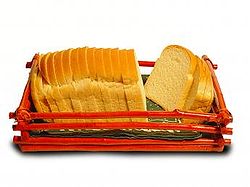도우 컨디셔너
Dough conditioner | |
| 주요 성분 | 밀가루, 물 |
|---|---|
반죽촉진제, 밀가루처리제, 개량제 또는 빵개량제는 식감을 강화하거나 다른 방법으로 개선하기 위해 빵 반죽에 첨가하는 성분 또는 화학약품이다.반죽 촉진제는 효소, 효모 영양소, 미네랄 솔트, 산화제 및 환원제, 표백제 및 [1]유화제를 포함할 수 있다.그것들은 베이킹 기능을 향상시키기 위해 밀가루와 조합된 식품 첨가물입니다.밀가루 처리제를 사용하여 반죽의 상승속도를 높이고 반죽의 강도 및 가공성을 향상시킨다.현대 공장 제빵의 중요한 구성 요소이지만, 일부 소규모 제빵사들은 더 깊은 [citation needed]맛을 내는 더 긴 발효 기간을 선호하여 제빵을 거부합니다.
이러한 약물은 소량만 필요하기 때문에 종종 콩가루 베이스의 혼합물로 판매된다.
예
반죽 컨디셔너의 예는 아스코르브산, 증류시킨 모노 글리 세리드가, 모노 글리 세리드가의 구연산 에스테르, diglycerides, 염화 암모늄, 모노 글리 세리드가의 enzymes,[2]는 디아세틸 타르타르 산 에스테르 또는 DATEM, 브론산 칼륨, 칼슘 iodate, L-cystine,[3]L-cysteine HCl,[4]글리세롤 monostearate, azodicarbonamide,[5]는 경우에는 6 같은 칼슘염을 포함한다.]나트륨 stearo락틸레이트, 팔미틴산수크로스 또는 수크로스 에스테르, 폴리옥시에틸렌 소르비탄 모노스테아레이트 또는 폴리소르베이트, 콩 레시틴, 리소포스폴리피드로 [7]농축된 콩 레시틴.
덜 가공된 반죽 촉진제는 싹트거나 맥아로 만든 곡물 가루, 콩, 우유, 밀 배아, 달걀, 감자, 글루텐, 효모 및 여분의 반죽을 포함한다.맥아, 디아스타틱 가루는 일반적으로 제조업체에 의해 통밀 가루에 첨가되지 않습니다.로버트슨 외 연구진은 제빵사들이 여전히 [8]손으로 반죽을 할 때 출판된 제빵책에서 더 나은 정보 중 일부가 발견된다고 지적한다.
역사
1900년대 초반에는 염화칼슘, 황산암모늄, 브롬산칼륨의 사용이 발견되었고, 반죽을 키우는 데 필요한 효모의 양을 절반으로 줄였다.이러한 혼합물은 일반적으로 미네랄 효모 식품 또는 효모 영양소 소금으로 알려져 있습니다.그것들이 제빵사들 사이에서 인기를 끈 후, 코네티컷 농업 실험소의 수석 화학자 J.P.에 의해 특허받은 효모 식품이 분석되었다.1917년에 "황산칼슘, 25; 염소산암모늄, 9.7; 브롬산칼륨, 0.3; 염소산나트륨, 25; 특허밀가루,[9] 40"을 함유했다고 출판한 거리.물 조절제, 효모 조절제,[10] 반죽 조절제가 들어 있습니다.
효모영양소
효모는 물, 전분 및 단순 탄수화물 등의 탄소원, 바람직하게는 질산염, 황, 인(종종 무기인산염)을 흡수할 수 없는 암모늄, 황, 인(종종 무기인산염), Cu, Fe, K, Mo, Mn,[11] Mg, Ni 및 Zn을 포함한 미량의 비타민과 원소 미네랄 이온을 필요로 한다.질소의 [12][13][14][1]공급원으로 염화암모늄, 황산암모늄 또는 인산암모늄을 사용할 수 있다.효모 [15]자극제로는 산성제인 인산염이 사용된다.산화제인 [16][17]요오드산칼슘은 일반적으로 칼슘의 안전 또는 GRAS 공급원으로 알려진 [18][19]미국 식품의약국입니다.
산화제 및 환원제
글루텐 발달을 돕기 위해 밀가루에 산화제를 첨가한다.표백제의 역할을 할 수도 있고 하지 않을 수도 있다.원래 밀가루는 대기에 노출되어 자연적으로 숙성되었다.산화제는 주로 유황 함유 아미노산에 영향을 미쳐 궁극적으로 글루텐 분자 사이에 이황화물 가교를 형성하는데 도움을 줍니다.밀가루에 이 성분들을 첨가하면 더 강한 [20]반죽을 만들 수 있다.디히드로아스코르브산 및 브롬산칼륨은 밀 반죽의 술프하이드릴기 및 디술피드 결합, 특히 글루타티온 산화에 작용하는 산화제이다.브롬산칼륨은 아스코르브산보다 더 직접적으로 작용하거나 화학적 전환 단계가 더 적습니다.글루타치온은 밀 반죽의 신축성을 증가시키거나 완화시키는 반면, 반죽의 글루타치온을 산화시키면 탄력성이 높아집니다.일반적인 산화제는 다음과 같습니다.
- 아스코르브산[21](Ascorbic acid) (Ascorbic acid는 혼합 중에 산화 형태인 deidroascorbic acid(DHAA)로 변환됩니다.)
- 아조디카본아미드(E927)
- 브롬산칼륨(E924, 주로 미국 동부와 중서부에서 사용되는 브롬화 밀가루의 이름을 부여하는 성분으로, 일부 지역에서는 금지된 표백제 역할을 한다.
- 요오드산칼륨
환원제는 단백질 네트워크를 파괴함으로써 밀가루를 약화시키는 데 도움이 된다.이것은 강한 반죽을 다루는 다양한 측면에 도움이 될 것이다.이러한 약제를 첨가하는 이점은 혼합 시간 단축, 반죽 탄성 감소, 프루프 시간 단축, 가공성 [20]향상입니다.시스테인과 중황산염은[note 1] 밀 [23][24]반죽을 이완시키는 환원제이다.미량의 산화제를 첨가하거나 환원제를 첨가하면 [25][26][27][28]반죽의 혼합 후 취급 특성이 변화한다.일반적인 환원제는 다음과 같습니다.
유화제
레시틴, 모노글리세리드, 디글리세리드, DATEM 등이 유화제로 여겨진다.그들은 반죽 전체에 지방을 더 고르게 분산시켜 [30]효모에 의해 생성된 이산화탄소를2 더 많이 가두는 것을 돕는다.밀가루 무게의 0.25~0.6%의 비율로 첨가된 레시틴은 반죽 촉진제 [31]역할을 한다.총 무게 기준으로 계란 노른자에는 약 9%[32]의 레시틴이 함유되어 있습니다.모노글리세리드와 디글리세리드는 구운 [33]제품의 달걀을 대체한다.유화제는 알갱이가 가늘고, 부스러기가 부드러워지며, 증류 시간이 길어질수록 소성 부피가 증가하며, 밀착 방지 [34][7]효과가 있습니다.
효소
효소는 또한 처리 특성을 개선하기 위해 사용됩니다.효모는 자연적으로 아밀라아제 및 단백질 분해 효소를 생성하지만, 더 빠르고 완벽한 반응을 만들기 위해 추가 양을 추가할 수 있습니다.
- 아밀라아제들은 밀가루 속의 전분을 단당으로 분해하여 효모를 빠르게 발효시킨다.맥아는 아밀라아제의 천연 공급원이다.
- 단백질 분해효소는 글루텐의 일부를 분해함으로써 반죽의 확장성을 향상시킨다.
- 리폭시게나아제는 [35]밀가루를 산화시킨다.
기타 에이전트
다른 첨가물은 효모 영양소 또는 효소의 소스로 사용될 수 있다.
「 」를 참조해 주세요.
메모들
레퍼런스
- ^ a b Lallemand Baking Update. "Dough conditioners" (PDF).
- ^ Wolfgang Aehle, ed. (2007). Enzymes in Industry: Production and Applications. Weinheim: Wiley-VCH. ISBN 978-3-527-31689-2.
- ^ Yamada, Y.; Preston, K.R. (1994). "Sponge-and-dough bread: Effects of oxidants on bread and oven rise properties of a Canadian red spring wheat patent flour" (PDF). Cereal Chemistry. 73 (3): 297–300.
- ^ Ravi, R.; Manohar, R.; Rao, P. (2000). "Influence of additives on the rheological characteristics and baking quality of wheat flours". European Food Research and Technology. 210 (3): 202–208. doi:10.1007/PL00005512. S2CID 84732563.
- ^ "Frequently Asked Questions on Azodicarbonamide (ADA)". FDA. 11 February 2020.
- ^ Clyde E. Stauffer (1990). Functional Additives for Bakery Foods. Van Nostrand Reinhold. p. 8. ISBN 978-0442003531. LCCN 90-37356.
Azodicarbonamide is frequently added to bread flour at the mill [in one-third of the cases in the survey done by Kulp (1981) referred to earlier]. Potassium bromate was added to 19% of the flours, and ascorbic acid to one (out of 63). This is done as a convenience for the bakery customer, who specifies the level of addition to obtain the best performance on the production line without having to add more oxidant in the plant. In the United States the maximum level of addition to flour is 45 ppm for ADA, 75 ppm for potassium bromate, and 200 ppm for ascorbic acid, although more typical dosing levels are 10 ppm, 25 ppm, and 50 ppm, respectively. Certain other materials may be also added at the mill, notably a-amylase (as malted barley powder or fungal enzyme) and vitamin enrichment to meet FDA standards for enriched flour....
- ^ a b Gómez, M.; Del Real, S.; Rosell, C.M.; Ronda, F.; Blanco, C.A.; Caballero, P.A. (2004). "Functionality of different emulsifiers on the performance of breadmaking and wheat bread quality". European Food Research and Technology. 219 (2): 145–150. doi:10.1007/s00217-004-0937-y. S2CID 94414171.
- ^ Laurel Robertson; Carol Flinders; Bronwen Godfrey (2003). The Laurel's kitchen bread book: a guide to whole-grain breadmaking (Random House trade paperback ed.). New York: Random House. ISBN 978-0-8129-6967-2. Retrieved May 14, 2011. 기사 "Laurel's Kitchen"을 참조하십시오.
- ^ "The Journal of the American Medical Association". 71 (1). American Medical Association. 1918: 282.
{{cite journal}}:Cite 저널 요구 사항journal=(도움말) - ^ Yiu H. Hui, ed. (2006). Handbook of Food Science, Technology, and Engineering. Vol. 4. pp. 148–32. ISBN 978-0-8493-9849-0. LCCN 2005050551.
- ^ Dennis E. Briggs; Chris A. Boulton; Peter A. Brookes; Roger Stevens (2004). "12.3". Brewing Science and practice. Cambridge, England: Woodhead Publishing Limited. ISBN 978-1-85573-490-6.
- ^ Rodrigues, M.S.; Ferreira, L.S.; Converti, A.; Sato, S.; Carvalho, J.C.M. (2010). "Fed-batch cultivation of Arthrospira (Spirulina) platensis: potassium nitrate and ammonium chloride as simultaneous nitrogen sources". Bioresource Technology. 101 (12): 4491–4498. doi:10.1016/j.biortech.2010.01.054. PMID 20153635.
- ^ Fulmer, E.I.; Nelson, V.E.; Sherwood, F.F. (1921). "The Nutritional Requirements Of Yeast. II. The Effect Of The Composition Of The Medium On The Growth Of Yeast". Journal of the American Chemical Society. 43 (1): 191–199. doi:10.1021/ja01434a027.
- ^ Di Carlo, F.J.; Schultz, A.S.; McManus, D.K. (1951). "The assimilation of nucleic acid derivatives and related compounds by yeasts" (PDF). Journal of Biological Chemistry. 189 (1): 151–157. doi:10.1016/S0021-9258(18)56104-4. PMID 14832226.
Table 1
- ^ Claudia Ruiz-Capillas; Leo M.L. Nollet, eds. (2016). Flow Injection Analysis of Food Additives (PDF). CRC Press. p. 262. ISBN 978-1-4822-1820-6.
- ^ Pearce, E.N.; Pino, S.; He, X.; Bazrafshan, H.R.; Lee, S.L.; Braverman, L.E. (2004). "Sources of dietary iodine: bread, cows' milk, and infant formula in the Boston area". The Journal of Clinical Endocrinology & Metabolism. 89 (7): 3421–3424. doi:10.1210/jc.2003-032002. PMID 15240625.
Conditioners are added to store-bought bread to maintain freshness and prolong shelf life. In the 1960s, iodate bread conditioners were widely used. London et al. (13), in 1965, reported that bread was a source of large quantities of dietary iodine, with iodine content as high as 150 μg per slice. This was considered to be a contributing cause to the decreasing radioactive iodine uptake in the U.S. during the 1960s (14, 15). Because of the concerns about high bread iodine content, commercial bakeries now less commonly use iodate bread conditioners. The decreasing use of iodate bread conditioners is thought to have contributed to the reduction in dietary iodine levels between the 1970s and the early 1990s.
- ^ "CALCIUM IODATE".
- ^ Fairweather-Tait, S.J.; Teucher, B. (2002). "Iron and calcium bioavailability of fortified foods and dietary supplements". Nutrition Reviews. 60 (11): 360–367. doi:10.1301/00296640260385801. PMID 12462518.
- ^ Swoboda, F.K. (1922). "Nitrogen nutrition of yeast" (PDF). Journal of Biological Chemistry. 52 (1): 91–109. doi:10.1016/S0021-9258(18)85854-9.
CaCl2
- ^ a b Hui and Corke 2006, 페이지 233.
- ^ "Ascorbic acid". Sustain. Retrieved 8 July 2014.
- ^ Manley, Duncan (2000). Technology of Biscuits, Crackers, and Cookies (3rd ed.). Woodhead Publishing Limited and CRC Press LLC. p. 197. ISBN 0-8493-0895-X.
- ^ Lallemand Baking Update. "A Guide to Reducing Agents" (PDF).
- ^ Baking Association of Canada. "L-Cysteine" (PDF).
- ^ Dong, W.; Hoseney, R.C. (1995). "Effects of Certain Breadmaking Oxidants and Reducing Agents on Dough Rheological Properties" (PDF). Cereal Chemistry. 72 (1): 58–64.
- ^ Elkassabany, M.; Hoseney, R.C.; Seib, P.A. (1980). "Ascorbic Acid as an Oxidant in Wheat Flour Dough. I. Conversion to Dehydroascorbic Acid" (PDF). Cereal Chemistry. 57 (2): 85–87. Archived from the original (PDF) on 2013-05-04. Retrieved 2017-01-23.
- ^ Elkassabany, M.; Hoseney, R.C. (1980). "Ascorbic Acid as an Oxidant in Wheat Flour Dough. II. Rheological Effects" (PDF). Cereal Chemistry. 57 (2): 88–91.
- ^ Popper, Lutz. "18.3 Oxidation and Flour Maturation" (PDF).
- ^ "Sodium Bisulfite". BAKER-pedia.
- ^ Brown, Amy L. (2008). Understanding food: principles and preparation. Belmont, CA: Thomson/Wadsworth. p. 352. ISBN 978-0-495-10745-3. Retrieved 2013-03-20.
- ^ O'Brien, Richard (2008). Fats and Oils Formulating and Processing for Applications, Third Edition: Formulating and Processing for Applications, Second Edition. Boca Raton: CRC. p. 319. ISBN 978-1-4200-6166-6. Retrieved 2013-03-20.
Protein complexing: The ability to complex with the protein in flour (gluten) provides the basis for a good dough conditioner. Lecithin can function as a natural bread-dough conditioner at addition levels generally between 0.25 and 0.6% based on the weight of the flour.
- ^ Chris Clarke (2004). The science of ice cream. Cambridge, Eng: Royal Society of Chemistry. p. 49. ISBN 978-0-85404-629-4. Retrieved 2013-03-20.
Egg yolk has the approximate composition (by weight) of 50% water, 16% protein, 9% lecithin, 23% other fat, 0.3% carbohydrate and 1.7% minerals.
- ^ "Hostess Bankruptcy And Science Prove Twinkies Are Not Immortal.. (n.d.)". The Free Library. 2014. Retrieved Sep 28, 2014.
The cake also has emulsifying chemicals called monoglycerides and diglycerides, which replace most of the eggs that would normally be used in a baked good.
- ^ Sun, Da-Wen (2011). Handbook of Frozen Food Processing and Packaging, Second Edition (Contemporary Food Engineering). Boca Raton: CRC Press. p. 518. ISBN 978-1-4398-3604-0. Retrieved 2013-03-20.
- ^ Tenbergen, Klaus. "Dough and Bread Conditioners". Food and Product Design Magazine. Retrieved 31 July 2012.
참고 문헌
- Hui Y와 Cork H(2006).베이커리 제품: 과학과 기술.블랙웰 출판사
외부 링크
- ADA는 우리의 아군입니까, 아니면 적입니까?베이커피디아에서


